
Bill Williams é o criador de alguns dos indicadores de mercado mais populares: Awesome Oscillator, Fractals, Alligator e Gator.

Não perca seu tempo. Acompanhe o impacto das NFP no dólar dos EUA!
Aviso de coleta de dados
Nós mantemos um registo dos seus dados para fazer funcionar este sítio web. Ao clicar no botão, concorda com a nossa Política de Privacidade.

Livro de Forex para principiantes
O seu grande guia no mundo do trading.
Confira a sua caixa de entrada!
Encontrará no nosso e-mail o Livro Básico de Forex. Basta tocar no botão para obtê-lo!
Alerta de risco: ᏟᖴᎠs são instrumentos complexos e vêm com um alto risco de perda rápida do dinheiro devido à alavancagem.
71,43% das contas de investidores de retalho perdem dinheiro ao negociar ᏟᖴᎠs com este provedor.
Deve considerar se entende como funcionam os ᏟᖴᎠs e se tem condições de assumir o alto risco de perder o seu dinheiro.
2022-08-26 • Atualizado
Informação não é consultoria em investimentos
Se chegou aqui, você já deve ter aprendido o básico. Agora é hora de falar sobre estratégias de trading! Hoje vamos discutir as três estratégias mais populares e úteis. Depois de ler este artigo, experimente-as em uma conta demo. Essas estratégias ajudam a entender como funciona o trading e servem como plano de ação.
Você vai se surpreender com a quantidade de informação que uma única vela pode trazer sobre o mercado. Note que esta estratégia lida com velas japonesas.
O melhor exemplo é o chamado padrão Martelo (Hammer, em inglês), capaz de sinalizar o fim de uma tendência de queda, um ponto de mínimo ou um nível de suporte. É bem fácil notar esse padrão no gráfico, já que ele se parece com um martelo — seu traçado forma um cabo alongado e uma cabeça. O cabo, isto é, a sombra da vela, deve ter pelo menos o dobro do comprimento do corpo verdadeiro. Procure por essa vela após uma queda no preço. Essa condição é importante. Espere até a vela Martelo fechar: até lá, a forma da vela pode mudar. Pode ser que não seja um martelo, afinal.
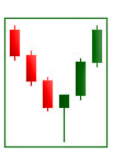
Compre quando a vela seguinte começar a se formar, ou, caso queira ter uma confirmação, quando a vela seguinte fechar acima do preço de abertura da vela à esquerda do Martelo. A cor do Martelo não importa, mas, se ela for verde, o sinal de compra é mais forte.
Veja como o Martelo se parece no gráfico real:
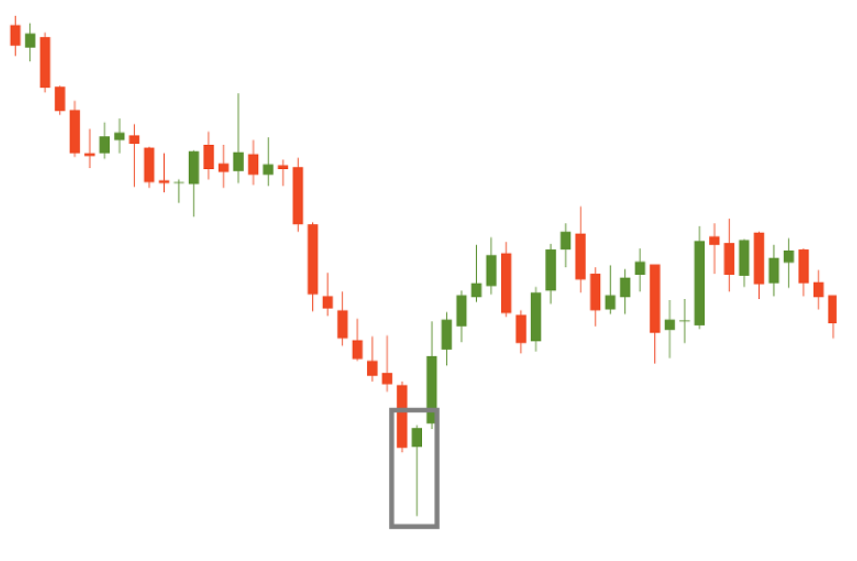
A Estrela Cadente (Shooting Star, em inglês) é bem semelhante ao Martelo. Ela também é um padrão de uma só vela. O corpo da vela também é pequeno, e a sombra também é pelo menos o dobro do corpo. Porém, ao contrário do Martelo, a Estrela Cadente tem a sombra acima do corpo e é sinal de venda. A vela pode ser de qualquer cor, mas, se for vermelha, o sinal de venda é mais forte.
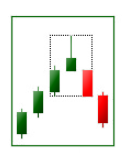
Veja como a Estrela Cadente se parece no gráfico real:

A estratégia anterior lidava com padrões de vela. Vamos agora aos padrões de gráfico, simples e eficientes.
O padrão Cabeça e Ombros (Head and Shoulders, em inglês) acontece no fim de uma tendência de alta. Ele é formado por uma cabeça (o segundo pico, que é o mais alto de todos), dois ombros (os picos mais baixos) e um “decote” (linha que liga os pontos mais baixos das duas descidas e representa um nível de suporte). A linha de pescoço pode ser horizontal ou inclinada para cima/para baixo. O sinal é mais confiável quando a inclinação é para baixo do que para cima.
O padrão se confirma quando o preço rompe abaixo do decote após formar o segundo ombro. É provável que o preço inicie uma tendência de queda após isso acontecer. Logo, coloca-se uma ordem de venda abaixo do decote. Meça a distância entre o ponto mais alto da cabeça e o decote. Essa distância é aproximadamente a distância que o preço se deslocará após romper abaixo do decote.
Note que os preços tendem a retornar ao decote após o rompimento inicial. Neste caso, o decote que inicialmente funcionou como suporte costuma funcionar como resistência.
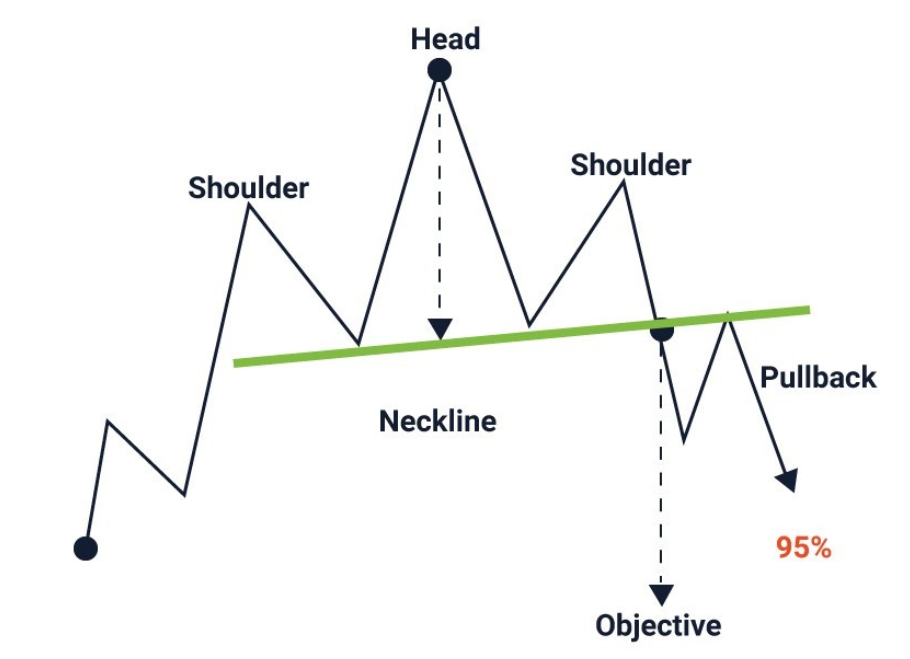
O padrão Cabeça e Ombros Oposto é, como indica o próprio nome, exatamente o oposto do padrão Cabeça e Ombros original. Ele acontece no final de uma tendência de queda e indica uma virada bullish (para cima).
O Topo Duplo (Double Top, em inglês) também costuma se formar no final de uma tendência de alta e é utilizado pelos traders com grande frequência. O padrão é formado por dois picos consecutivos de alturas semelhantes (ou quase semelhantes), com uma cova moderada entre eles. O “decote” é desenhado horizontalmente através do ponto mais baixo de uma cova.
O padrão é confirmado quando o preço rompe abaixo do decote após formar o segundo ombro. Quando isso acontece, o par de moedas deve iniciar uma tendência de queda. Coloque uma ordem de venda abaixo do decote. Meça a distância entre os picos e o decote — o preço deve se deslocar aproximadamente essa distância após romper o decote. Após o rompimento, o preço pode voltar ao decote por um breve intervalo antes de retomar sua trajetória. Essa é uma boa oportunidade de abrir uma ordem de venda a um preço mais alto.
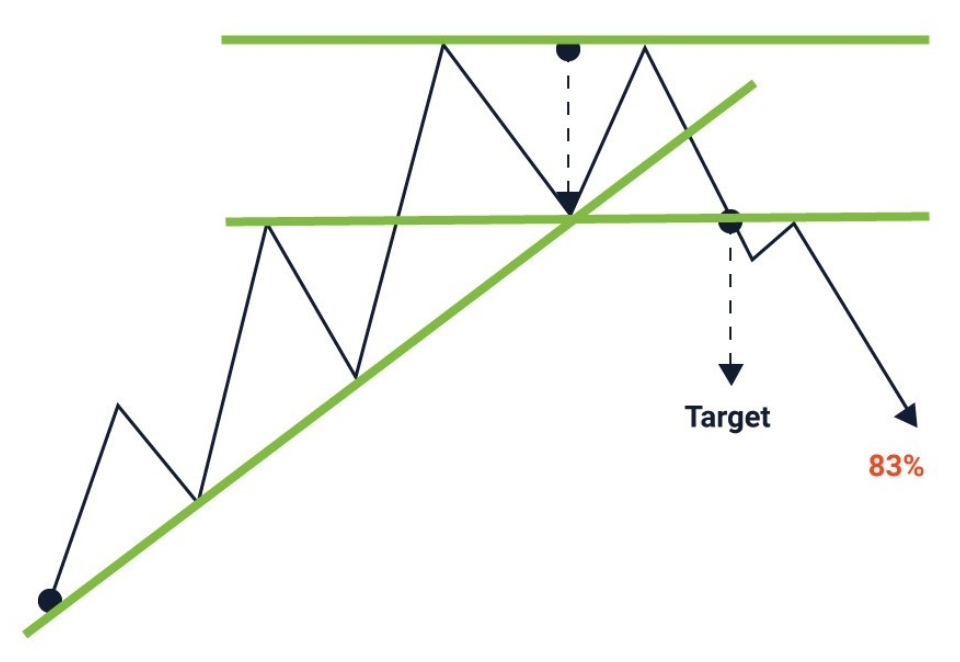
O fundo duplo é exatamente o oposto do topo duplo. Ele acontece no final de uma tendência de queda e indica uma virada bullish (para cima).
Topo Triplo e Fundo Triplo são padrões semelhantes, porém com três picos/covas. A lógica do trading aqui é a mesma.
Nas estratégias anteriores, utilizamos nada além do gráfico de preços. Agora é hora de aplicar um indicador técnico chamado Média Móvel. Utilizamos as siglas MM ou MA (do inglês Moving Average).
A média móvel é um indicador de tendência. A MA mostra o preço médio em um dado intervalo de tempo, sendo suas flutuações mais suaves do que aquelas observadas no gráfico de preço. Exemplo: se temos uma MA de 10 dias, calculamos a soma dos últimos 10 preços e dividimos ela por 10. À medida que as novas velas aparecem no gráfico, as velas mais antigas deixam de ser contabilizadas.
Existem quatro tipos de MA: simples, exponencial, linear ponderada e suavizada. Recomendamos começar com o tipo simples.
No menu superior, clique em Inserir, procure por Indicadores, escolha Tendência e, por fim, selecione Moving Average. Aplicar os ajustes corretos é extremamente importante.
Período é o número de velas que serão levadas em conta nos cálculos. Quanto maior o período, mais suave é a MA. Quanto menor o período, mais próxima a MA fica do preço.
Os traders preferem MAs com períodos de 50, 100 e 200 para timeframes maiores e de 9, 12 e 26 para timeframes menores.
São várias opções. Pode ser o de fechamento, de abertura, máximo, mínimo, médio, típico e o de fechamento ponderado. Os traders geralmente usam o preço de fechamento.
Este ajuste é usado para deslocar o indicador para frente e para trás na escala de tempo, o que faz a MA se deslocar para a direita ou para a esquerda.
Você pode usar a MA como um indicador de tendência: se ela está em queda, tem-se uma tendência de queda; se ela está em alta, tem-se uma tendência de alta. Além disso, o cruzamento (crossover) de Médias Móveis pode ajudar o trader a decidir quando entrar e sair do mercado. Esse cruzamento acontece quando duas MAs distintas se cruzam. São dois os tipos de cruzamentos: o dourado e o morto.
Quando uma MA de período menor cruza uma MA de período maior de baixo para cima, trata-se de um sinal de compra.
Quando uma MA de período menor cruza uma MA de período maior de cima para baixo, trata-se de um sinal de venda.


Note que o cruzamento dourado geralmente funciona quando o preço está acima da MA. Já o cruzamento morto costuma funcionar quando o preço está abaixo da MA.
Vamos resumir o que você aprendeu hoje:
Ótimo! Você já está apto a empregar todas essas estratégias de trading. Como todos sabem, a prática é a melhor forma de digerir informações. Vá em frente, pratique!

Bill Williams é o criador de alguns dos indicadores de mercado mais populares: Awesome Oscillator, Fractals, Alligator e Gator.

As estratégias de tendência são boas: podem gerar resultados consideravelmente bons em qualquer tempo gráfico e com qualquer ativo. A ideia principal da estratégia ADX é tentar apanhar o arranque da tendência.

As estratégias de contratendência são sempre as mais perigosas, porém as mais lucrativas. Temos o prazer de apresentar uma excelente estratégia de contratendência que funciona em qualquer mercado e com qualquer ativo.
Seu pedido foi aceito
Faremos contacto no intervalo de horário escolhido
O próximo pedido de contato para este número de telefone estará disponível em 00:30:00
Se tiver um problema urgente, por favor, contacte-nos via
Chat ao vivo
Erro interno. Por favor, tente novamente mais tarde